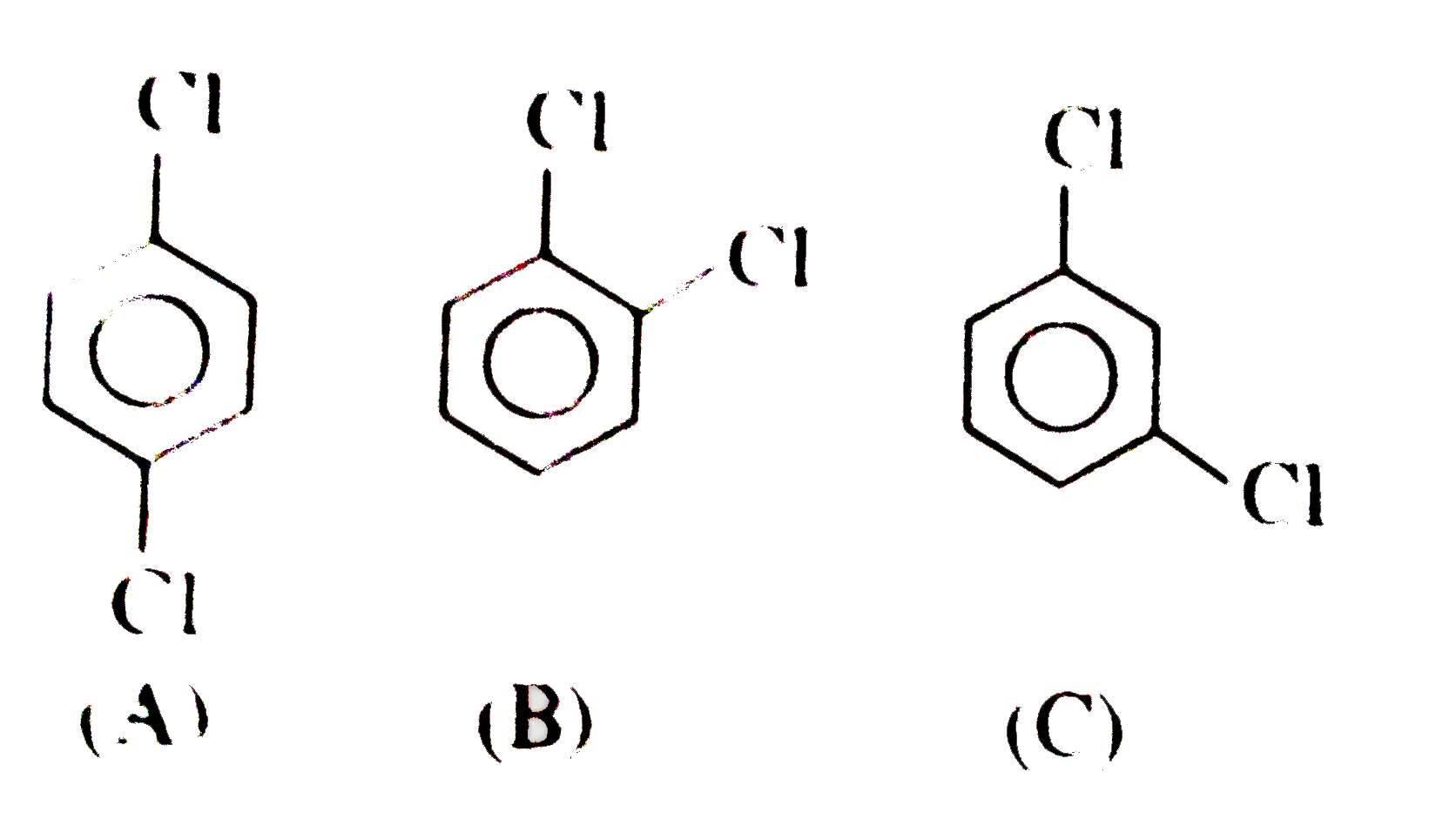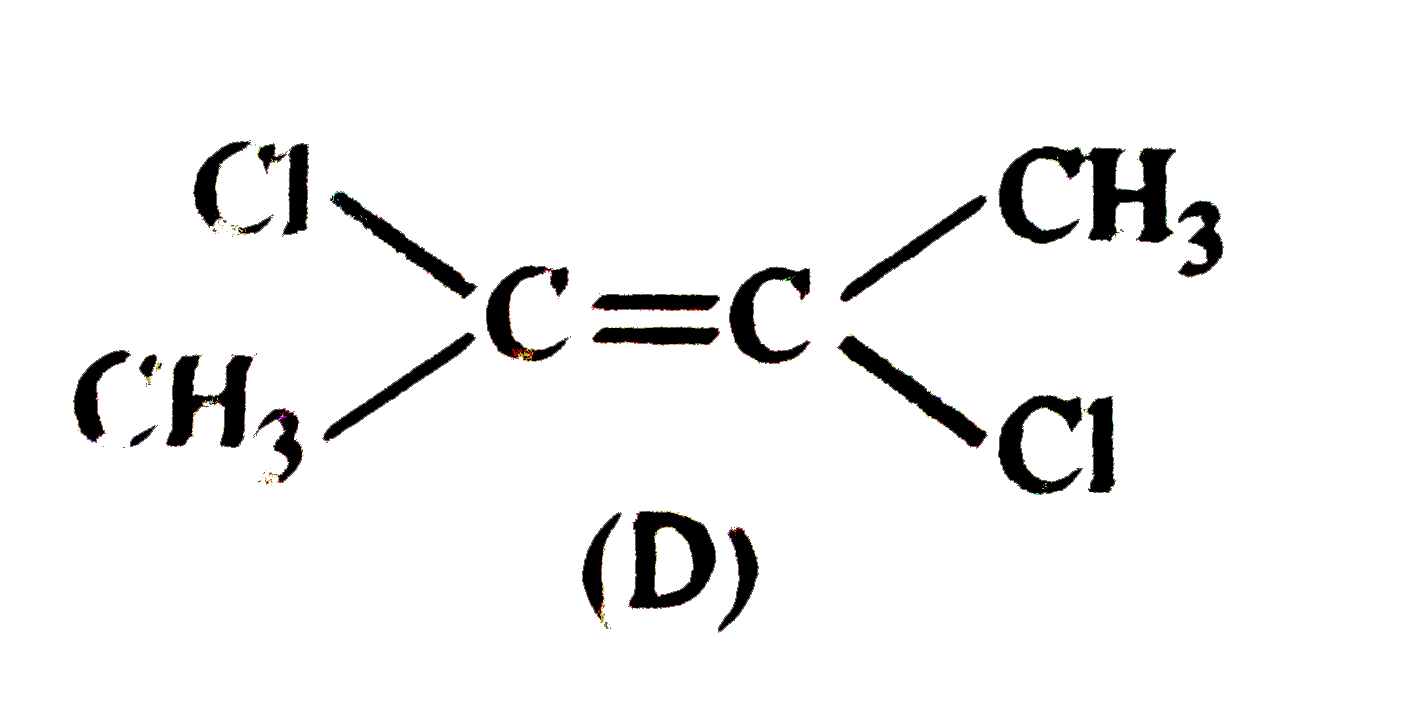A polar covalent bond with positive and negative charge centres at its ends is called a dipole. The polarity of a dipole is measured by its dipole moment. Mathematically it is expressed as dipole moment, μ=q×d where q and d are the net charge and the distance between the two charges respectively. Dipole moment is a vector quantity. The net dipole moment of a polyatomic molecule is the resultant of the various bond moments present in the molecule. The values of dipole moment are expressed in Debye (D) or in SI units in terms of coulomb- metre (Cm). One of the most important applications of dipole moment is in the determination of geometry and shape of molecules besides prediction of a number of properties of the molecules.
Maximum dipole moment is shown by
1, 4-dichlorobenzene
Cls 1, 2-dichlorobenzene
trans 1, 3-dichlorobenzene
trans 2. 3-dichloro-2-butene.
The correct Answer is:B
Topper's Solved these Questions
- CHEMICAL BONDING AND MOLECULAR STRUCTUREBook:DINESH PUBLICATIONChapter:CHEMICAL BONDING AND MOLECULAR STRUCTUREExercise:Matrix Match
Explore 4 Videos
- CHEMICAL BONDING AND MOLECULAR STRUCTUREBook:DINESH PUBLICATIONChapter:CHEMICAL BONDING AND MOLECULAR STRUCTUREExercise:Integer
Explore 4 Videos
- CHEMICAL BONDING AND MOLECULAR STRUCTUREBook:DINESH PUBLICATIONChapter:CHEMICAL BONDING AND MOLECULAR STRUCTUREExercise:REVISION
Explore 279 Videos
- CARBOXYLIC ACIDS Book:DINESH PUBLICATIONChapter:CARBOXYLIC ACIDS Exercise:BRAIN STORMING MULTIPLE CHOICE QUESTIONS (MCQS)
Explore 13 Videos
- CHEMICAL KINETICSBook:DINESH PUBLICATIONChapter:CHEMICAL KINETICSExercise:Additional Numerical Problems For Practice
Explore 16 Videos
Similar Questions
A polar covalent bond with positive and negative charge centres at its ends is called a dipole. The polarity of a dipole is measured by its dipole moment. Mathematically it is expressed as dipole moment, μ=q×d where q and d are the net charge and the distance between the two charges respectively. Dipole moment is a vector quantity. The net dipole moment of a polyatomic molecule is the resultant of the various bond moments present in the molecule. The values of dipole moment are expressed in Debye (D) or in SI units in terms of coulomb- metre (Cm). One of the most important applications of dipole moment is in the determination of geometry and shape of molecules besides prediction of a number of properties of the molecules.
The dipole moment of HBr is 0.78×10−18 esu cm. The bond length of HBr is 1.41 Ã…. The percentage ionic character of HBr is
View SolutionA polar covalent bond with positive and negative charge centres at its ends is called a dipole. The polarity of a dipole is measured by its dipole moment. Mathematically it is expressed as dipole moment, μ=q×d where q and d are the net charge and the distance between the two charges respectively. Dipole moment is a vector quantity. The net dipole moment of a polyatomic molecule is the resultant of the various bond moments present in the molecule. The values of dipole moment are expressed in Debye (D) or in SI units in terms of coulomb- metre (Cm). One of the most important applications of dipole moment is in the determination of geometry and shape of molecules besides prediction of a number of properties of the molecules.
Which of the following has net dipole moment?
View Solution
Knowledge Check
A polar covalent bond with positive and negative charge centres at its ends is called a dipole. The polarity of a dipole is measured by its dipole moment. Mathematically it is expressed as dipole moment, μ=q×d where q and d are the net charge and the distance between the two charges respectively. Dipole moment is a vector quantity. The net dipole moment of a polyatomic molecule is the resultant of the various bond moments present in the molecule. The values of dipole moment are expressed in Debye (D) or in SI units in terms of coulomb- metre (Cm). One of the most important applications of dipole moment is in the determination of geometry and shape of molecules besides prediction of a number of properties of the molecules.
Debye is equivalent toA3.33×10−30 e.s.u. cmB1.662×10−27 e.s.u.cmC1×10−18 e.s.u. cmD3.33×10−12 e.s.u.cm.A polar covalent bond with positive and negative charge centres at its ends is called a dipole. The polarity of a dipole is measured by its dipole moment. Mathematically it is expressed as dipole moment, μ=q×d where q and d are the net charge and the distance between the two charges respectively. Dipole moment is a vector quantity. The net dipole moment of a polyatomic molecule is the resultant of the various bond moments present in the molecule. The values of dipole moment are expressed in Debye (D) or in SI units in terms of coulomb- metre (Cm). One of the most important applications of dipole moment is in the determination of geometry and shape of molecules besides prediction of a number of properties of the molecules.
NH3 has a net dipole moment, while BF3 has zero dipole moment becauseANH3 is not a planar molecule while BF3 is planarBNH3 is a planar, while BF3 is non-planarCFluorine is more electropositive than nitrogenDBoron is more electronegative than oxygen.A polar covalent bond with positive and negative charge centres at its ends is called a dipole. The polarity of a dipole is measured by its dipole moment. Mathematically it is expressed as dipole moment, μ=q×d where q and d are the net charge and the distance between the two charges respectively. Dipole moment is a vector quantity. The net dipole moment of a polyatomic molecule is the resultant of the various bond moments present in the molecule. The values of dipole moment are expressed in Debye (D) or in SI units in terms of coulomb- metre (Cm). One of the most important applications of dipole moment is in the determination of geometry and shape of molecules besides prediction of a number of properties of the molecules.
H2O has a dipole moment while BeF, has zero dipole moment becauseAH2O molecule is linear while BeF2 is bentBBeF2, molecule is linear while H2O is bent oxygenCFluorine has more electronegativity than oxygenDBeryllium has more electronegativity than oxygen.
A polar covalent bond with positive and negative charge centres at its ends is called a dipole. The polarity of a dipole is measured by its dipole moment. Mathematically it is expressed as dipole moment, μ=q×d where q and d are the net charge and the distance between the two charges respectively. Dipole moment is a vector quantity. The net dipole moment of a polyatomic molecule is the resultant of the various bond moments present in the molecule. The values of dipole moment are expressed in Debye (D) or in SI units in terms of coulomb- metre (Cm). One of the most important applications of dipole moment is in the determination of geometry and shape of molecules besides prediction of a number of properties of the molecules.
A diatomic molecule has a dipole of 1.2 D, if the bond distance is 1 Ã…, what percentage of electronic charge exists on each atom.
View SolutionA polar covalent bond with positive and negative charge centres at its ends is called a dipole. The polarity of a dipole is measured by its dipole moment. Mathematically it is expressed as dipole moment, μ=q×d where q and d are the net charge and the distance between the two charges respectively. Dipole moment is a vector quantity. The net dipole moment of a polyatomic molecule is the resultant of the various bond moments present in the molecule. The values of dipole moment are expressed in Debye (D) or in SI units in terms of coulomb- metre (Cm). One of the most important applications of dipole moment is in the determination of geometry and shape of molecules besides prediction of a number of properties of the molecules.
The molecules BF3 and NH3 both are covalent compounds but BF3 is non-polar while NF3 is polar . The reason is that
View SolutionThe net dipole moment of H2O molecule is
View SolutionThe study of diple
moment of a molecule is useful to explain the
shape of a molecule and also to predict a
The net dipole moment of a polyatomic
molecule is the resltant of the different bond
moments present in that molecule . The values
are generalluy expressed in Debye or in the S.I.
units in terms of Coulomb meter (C m)
Which our of the following will have maximum
dipole moment ?
View SolutionDipole moment is defined as the product of charge and the
View Solution

